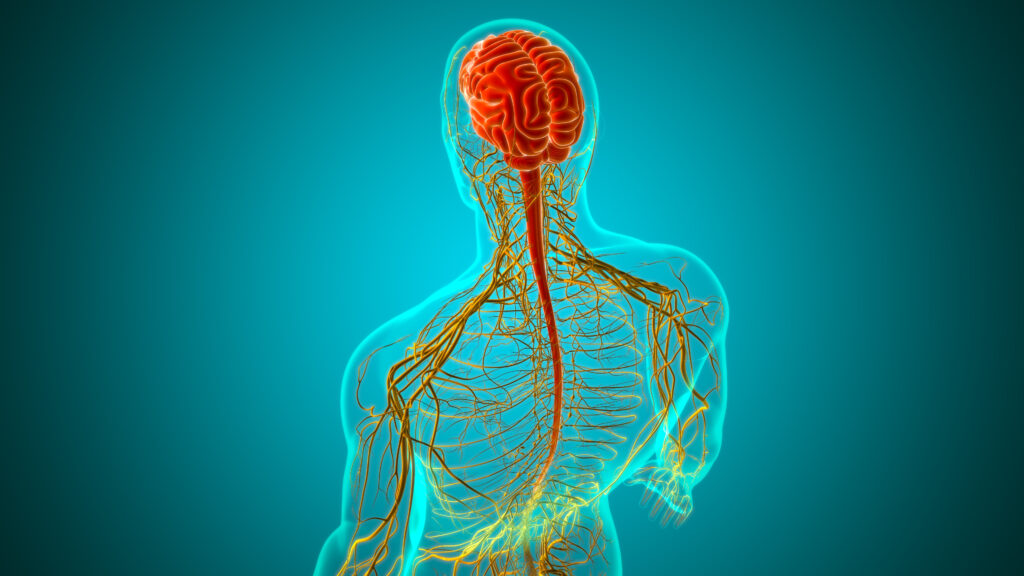The human body is an incredible thing that is capable of unbelievable feats. Many things make up the body, including bones, ligaments, nerves, and more. Today we’re going to be diving into the largest nerve of the body, what it does, and why it’s important.
What Are Nerves?

The human brain sends electrical impulses throughout the body through nerves, which act as wires.
©mybox/Shutterstock.com
Your brain sends electrical impulses to the other parts of the body through your nerves, which act as wires. These impulses can move your muscles and stimulate your senses. Moreover, they continue to carry out some autonomic processes like breathing, sweating, and food digestion.
Neurons are another name for nerve cells. Your body contains neurons, particularly in the brain and spinal cord. Your nervous system is built on your nerves, your brain, and your spinal cord. When doctors speak to the “nerve,” they typically mean the portion of your nervous system not connected to your spinal cord or brain. The medical name for this system is the peripheral nervous system.
The primary network of communication in your body is your nervous system. It regulates and sustains the numerous bodily processes along with your endocrine system. It also facilitates interaction with your environment.
The Structure of a Nerve

The nervous system is made up of a number of parts, each serving a specific function.
©VectorMine/Shutterstock.com
The peripheral nervous system is made up of a structure resembling a cord that is covered in layers of connective tissue and fat and contains numerous nerve fibers, also known as axons. These layers of tissue surround the axon. The endoneurium is the scientific term for connective tissue.
The epineurium is an additional layer of connective tissue that surrounds a whole nerve. Within the nerves, a collection of neurons is arranged into bundles. Fascicules are the name of this group. The perineurium surrounds and holds together each fascicle.
Cuboidal cells, collagen fibers, and basement membranes make up the perineurium, which forms circular layers. Endoneurium, an elastic tissue, holds blood vessels and neurons within the fascicles.
It protects and maintains the nerves’ external surfaces together. In between the fascicles, there are arteries and veins. The neurons within the fascicles receive their nutrients and gases from these blood channels.
Types of Nerves
There are three basic types of nerves in the human body, which are divided into groups based on their functions.
Mixed Nerves
Mixed nerves are the type of nerves that can function as both a motor nerve and a sensory nerve. They modify the central nervous system’s electrical impulses so that they can reach the body’s muscles. The mixed nerves typically send signals at a speed of 394 feet per second.
Sensory Nerves
These nerves allow the sensory organs to communicate with the brain or spinal cord. They are contained inside the peripheral nervous system and take the shape of bundle-like structures or nerve fibers. They transfer data between the peripheral nervous system and the central nervous system.
Motor Nerves
The nerves that send signals from the brain or spinal cord in the shape of a response to other parts of the body like the glands and muscle groups are motor nerves. They are in charge of transferring data between the central nervous system and the peripheral nervous system.
Biggest Nerve in the Body

The sciatic nerve (illustrated in red) is the longest and largest nerve in the body.
©SciePro/Shutterstock.com
The longest and largest nerve in your body is the sciatic nerve. Starting in the lower back, the sciatic nerve roots travel through the back of each leg. Sciatica is the sensation of discomfort or pain that results from a pinched or constricted sciatic nerve. Sciatica is more likely to affect those who are pregnant, lead sedentary lifestyles, or have diabetes.
The sciatic nerve starts just above your spine’s base, around the lumbar spine and sacral region. It passes through the start of the gluteus muscles, also known as your “butt,” and descends into your hamstrings and lower legs.
How Big Is the Sciatic Nerve?
The beginning of the sciatic nerve is just 1/2 an inch wide. The nerve gets slightly wider as it travels down your legs. Your sciatic nerve is roughly the size of a penny in diameter at its thickest point.
Five distinct nerve roots create your our sciatic nerve. Three nerve roots begin at the base of your spine, with two beginning in your lower back. These roots come together near the base of your spine to make the sciatic nerve!
Every one of the roots on the left side make up the left sciatic nerve, whereas all of the roots on the right side make up the right sciatic nerve.
Keeping Your Nervous System Healthy

Fortunately, some quite tasty foods contain the necessary nutrients to keep the nervous system healthy. Dark chocolate offers tryptophan, which the body uses to help make melatonin and serotonin.
©iravgustin/Shutterstock.com
Nerves require several minerals, proteins, and vitamins in order for them to transmit electrical impulses. The foods that supply these nutrients are fortunately tasty. Tryptophan, an amino acid found in large quantities in dark chocolate, is a neurotransmitter, or a chemical that transmits signals from one nerve ending to another.
These minerals, calcium, and potassium, control the electrical impulses that the nerves produce and transmit. A person may get epilepsy or other neurological illnesses if their nerves keeping continuing to fire off impulses unchecked.
A myelin sheath, which serves as protection for each nerve, surrounds it. It serves as insulation for the transmitting nerve in a manner similar to the sheath of an electric cable. It is crucial for a person to maintain their B12 intake because damaged myelin sheaths have been linked to conditions like Alzheimer’s.
When an individual is under stress from a job, interpersonal connections, or a challenging commute, it produces a concerning amount of the stress hormone cortisol. Cortisol affects the neurological system and impairs reflexes, focus, and cognition when it is continuously produced. Yoga practice on a regular basis will maintain a person’s cortisol levels low, promoting better nervous system function and a feeling of well-being.
The photo featured at the top of this post is © SciePro/Shutterstock.com
Thank you for reading! Have some feedback for us? Contact the AZ Animals editorial team.






